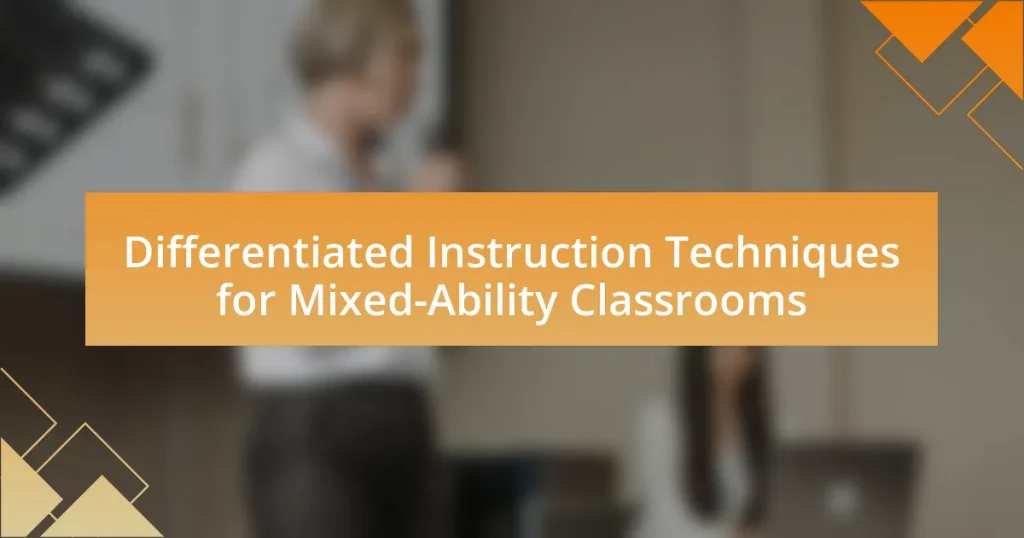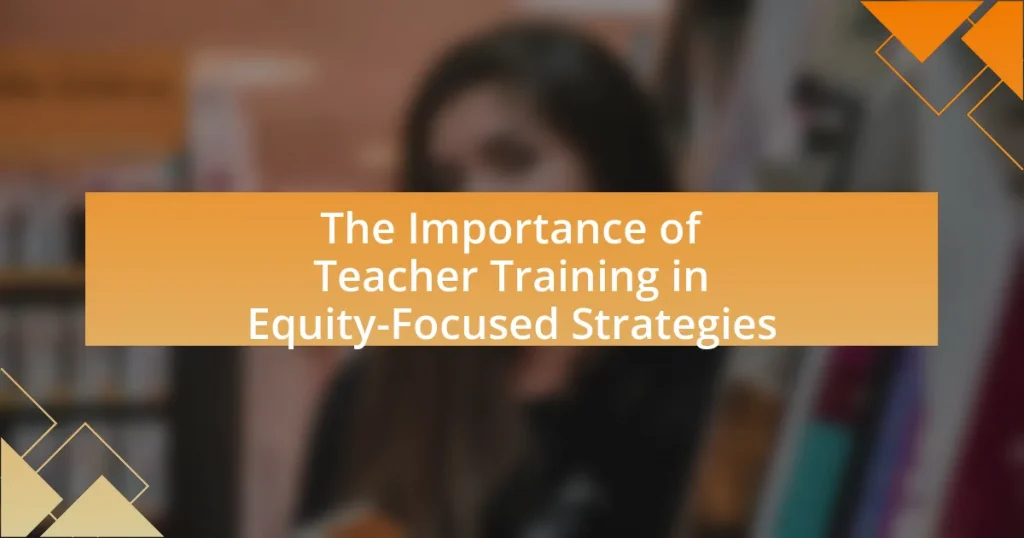Differentiated Instruction Techniques for Mixed-Ability Classrooms encompass various strategies aimed at addressing the diverse learning needs of students. Key techniques include flexible grouping, tiered assignments, and varied instructional methods, which facilitate targeted instruction and engagement. The article outlines how these techniques cater to individual differences in readiness, interest, and learning profiles, ultimately promoting equity and improving student outcomes. Additionally, it discusses the importance of assessment in guiding instructional decisions and highlights best practices for effective differentiation, including collaboration among educators and ongoing professional development opportunities.
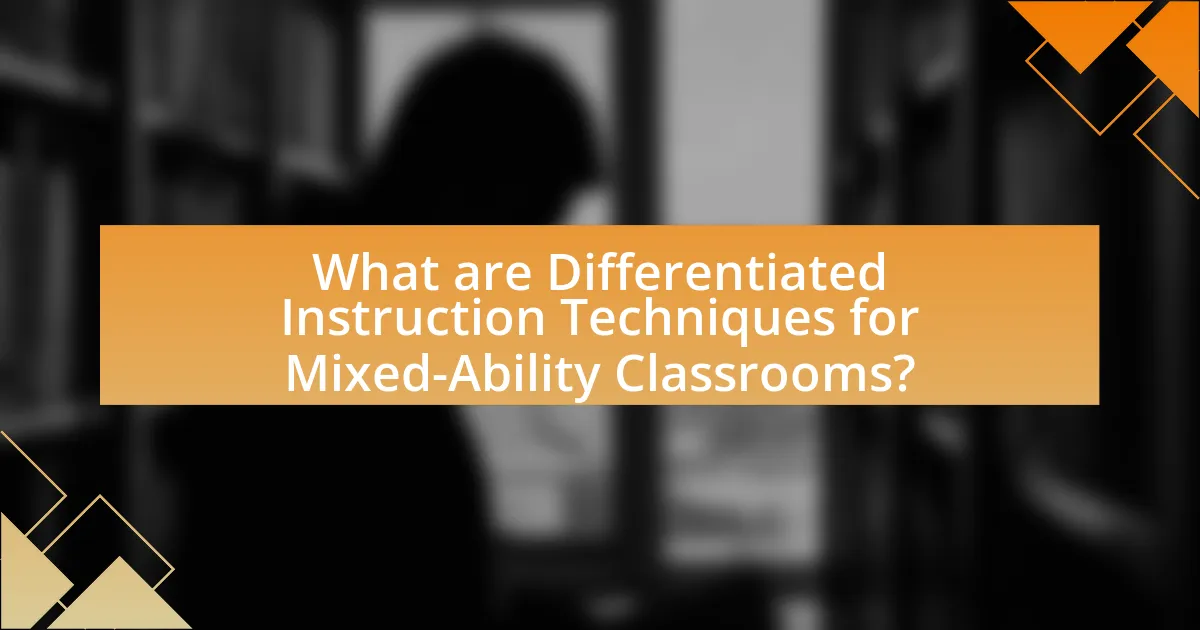
What are Differentiated Instruction Techniques for Mixed-Ability Classrooms?
Differentiated instruction techniques for mixed-ability classrooms include strategies such as flexible grouping, tiered assignments, and varied instructional methods. Flexible grouping allows teachers to organize students based on their skill levels or interests, facilitating targeted instruction. Tiered assignments provide different levels of tasks that cater to varying abilities, ensuring all students engage with the material at an appropriate challenge level. Varied instructional methods, such as using visual aids, hands-on activities, and technology, accommodate diverse learning styles and preferences. Research indicates that these techniques enhance student engagement and achievement by addressing individual learning needs, as supported by Tomlinson’s work on differentiated instruction.
How do Differentiated Instruction Techniques cater to diverse learning needs?
Differentiated Instruction Techniques cater to diverse learning needs by tailoring educational experiences to accommodate individual student differences in readiness, interest, and learning profiles. These techniques include flexible grouping, varied instructional strategies, and personalized assessments, which allow educators to meet the unique requirements of each learner. Research indicates that differentiated instruction can lead to improved student engagement and achievement, as evidenced by a study conducted by Tomlinson (2001) in “How to Differentiate Instruction in Mixed-Ability Classrooms,” which highlights that students in differentiated environments demonstrate higher levels of motivation and academic success.
What are the key principles of Differentiated Instruction?
The key principles of Differentiated Instruction include recognizing students’ varying backgrounds, readiness levels, interests, and learning profiles to tailor teaching methods accordingly. This approach emphasizes flexible grouping, ongoing assessment, and adjusting content, process, and product based on individual student needs. Research by Tomlinson (2001) highlights that effective differentiation leads to improved student engagement and achievement by addressing diverse learning requirements within a classroom.
How do these principles apply in a mixed-ability classroom setting?
Differentiated instruction principles apply in a mixed-ability classroom setting by tailoring teaching methods to accommodate diverse learning needs. Teachers can implement flexible grouping, allowing students to work in varied configurations based on their skill levels, interests, or learning profiles. This approach fosters collaboration and peer learning, enhancing engagement and understanding among students with different abilities. Research indicates that differentiated instruction can lead to improved academic outcomes, as evidenced by a study published in the “Journal of Educational Psychology,” which found that students in differentiated classrooms showed higher achievement levels compared to those in traditional settings.
Why is Differentiated Instruction important in education?
Differentiated Instruction is important in education because it addresses the diverse learning needs of students, enhancing their engagement and academic success. By tailoring teaching methods, materials, and assessments to accommodate varying abilities, interests, and learning styles, educators can foster a more inclusive classroom environment. Research indicates that differentiated instruction leads to improved student outcomes; for instance, a study by Tomlinson (2001) found that students in differentiated classrooms demonstrated higher levels of motivation and achievement compared to those in traditional settings. This approach not only supports individual learning paths but also promotes equity in education, ensuring that all students have the opportunity to succeed.
What impact does Differentiated Instruction have on student engagement?
Differentiated Instruction significantly enhances student engagement by tailoring learning experiences to meet diverse needs. This approach allows educators to provide varied instructional strategies, resources, and assessments, which cater to individual learning preferences and readiness levels. Research indicates that when students receive personalized instruction, they are more likely to participate actively in class discussions and activities, leading to increased motivation and a deeper understanding of the material. For instance, a study by Tomlinson (2001) found that classrooms employing differentiated strategies saw a marked improvement in student engagement and achievement, demonstrating the effectiveness of this instructional method in fostering a more inclusive and stimulating learning environment.
How does it promote equity in learning opportunities?
Differentiated instruction promotes equity in learning opportunities by tailoring educational experiences to meet the diverse needs of all students. This approach recognizes that learners have varying backgrounds, readiness levels, and interests, allowing educators to provide multiple pathways for students to access content, engage with material, and demonstrate understanding. Research indicates that when teachers implement differentiated strategies, such as flexible grouping and varied instructional methods, students from different ability levels can achieve higher academic outcomes, thereby reducing achievement gaps. For instance, a study by Tomlinson (2001) highlights that differentiated instruction leads to improved student engagement and performance, particularly for those who may struggle in traditional learning environments.
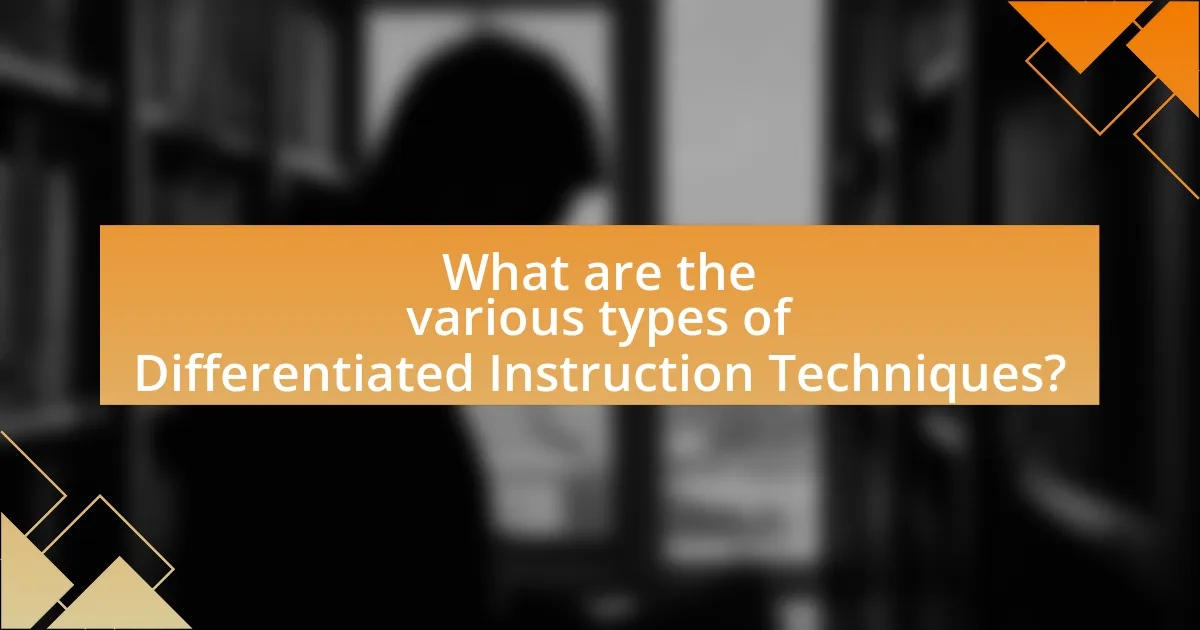
What are the various types of Differentiated Instruction Techniques?
Differentiated instruction techniques include various strategies designed to meet the diverse needs of learners in mixed-ability classrooms. These techniques encompass flexible grouping, where students are grouped by shared interest or ability; tiered assignments, which provide different levels of tasks based on student readiness; and learning centers, allowing students to engage with content at their own pace. Additionally, scaffolding offers support tailored to individual student needs, while choice boards give students options in how they demonstrate understanding. Research indicates that these methods enhance student engagement and achievement by addressing individual learning preferences and readiness levels.
How can teachers implement flexible grouping strategies?
Teachers can implement flexible grouping strategies by assessing students’ needs and interests to create diverse groups that change based on specific learning objectives. This approach allows teachers to tailor instruction to various skill levels and learning styles, enhancing engagement and collaboration among students. Research indicates that flexible grouping can lead to improved academic outcomes, as it fosters a supportive learning environment where students can learn from one another. For example, a study by Tomlinson (2001) in “How to Differentiate Instruction in Mixed-Ability Classrooms” highlights that varied grouping arrangements, such as pairs, small groups, or whole-class activities, can effectively address the diverse needs of learners.
What are the benefits of using small groups in instruction?
Using small groups in instruction enhances student engagement and promotes collaborative learning. Small groups allow for personalized interaction, enabling teachers to address diverse learning needs effectively. Research indicates that students in small groups demonstrate improved academic performance, as they benefit from peer support and varied perspectives. A study by Johnson and Johnson (2014) found that cooperative learning in small groups leads to higher achievement and greater retention of information compared to traditional whole-class instruction. Additionally, small groups foster communication skills and build social relationships, which are crucial for holistic development in mixed-ability classrooms.
How can teachers effectively manage group dynamics?
Teachers can effectively manage group dynamics by establishing clear roles and expectations within the group. This approach fosters accountability and encourages collaboration among students. Research indicates that when students understand their responsibilities and the group’s objectives, they are more likely to engage positively and contribute to the group’s success. For instance, a study published in the “Journal of Educational Psychology” found that structured group roles significantly improved student participation and satisfaction in collaborative tasks. By implementing strategies such as assigning specific roles, setting ground rules, and facilitating open communication, teachers can create a productive learning environment that enhances group dynamics.
What role does assessment play in Differentiated Instruction?
Assessment plays a critical role in Differentiated Instruction by providing educators with essential data to tailor their teaching strategies to meet diverse student needs. Through formative and summative assessments, teachers can identify individual learning styles, strengths, and areas for improvement, allowing for personalized learning experiences. Research indicates that effective assessment practices, such as ongoing feedback and varied assessment methods, enhance student engagement and achievement in mixed-ability classrooms. For instance, a study by Tomlinson (2001) highlights that differentiated assessments lead to improved student outcomes by aligning instruction with specific learner profiles.
How can formative assessments guide instructional decisions?
Formative assessments guide instructional decisions by providing real-time feedback on student understanding and performance. This feedback allows educators to identify learning gaps and adjust their teaching strategies accordingly. For instance, data from formative assessments can reveal which concepts students struggle with, enabling teachers to tailor their lessons to address these specific areas. Research indicates that when teachers utilize formative assessment data, student achievement can improve significantly, as evidenced by a study published in the “Review of Educational Research,” which found that formative assessments can lead to a 20% increase in student performance when effectively integrated into instruction.
What types of assessments are most effective for mixed-ability classrooms?
Formative assessments are the most effective for mixed-ability classrooms. These assessments, such as quizzes, observations, and peer assessments, allow teachers to gauge student understanding in real-time and adjust instruction accordingly. Research indicates that formative assessments can improve student achievement by providing immediate feedback and fostering a growth mindset, which is crucial in diverse learning environments. According to a study by Black and Wiliam (1998), formative assessment practices can lead to significant learning gains, particularly in mixed-ability settings where students have varying levels of prior knowledge and skills.
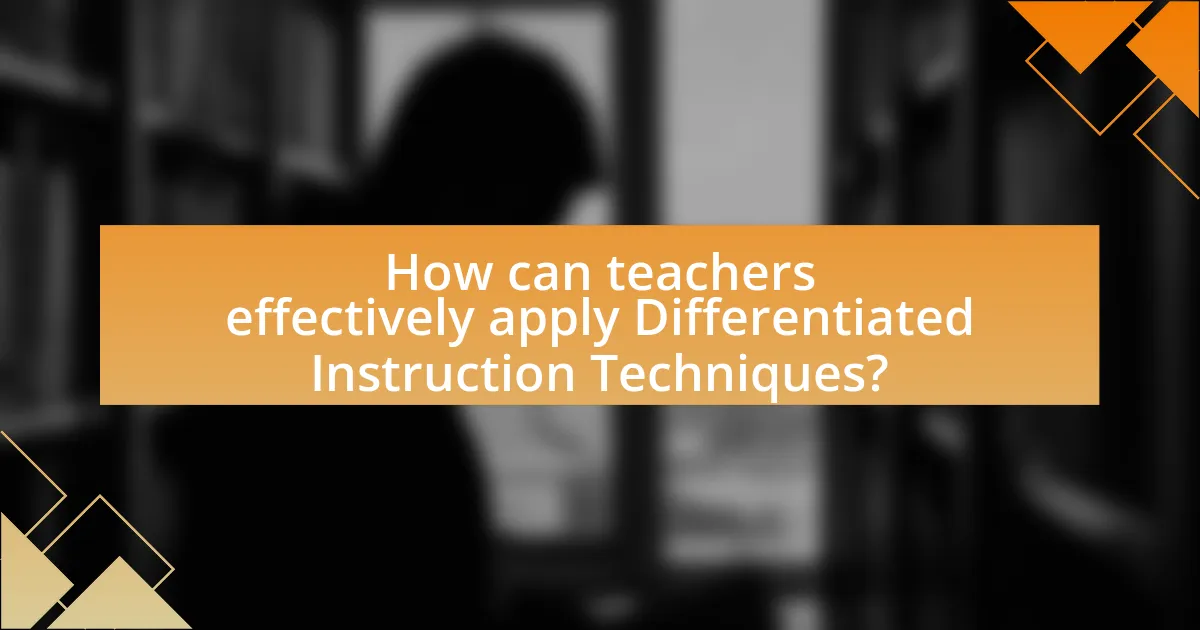
How can teachers effectively apply Differentiated Instruction Techniques?
Teachers can effectively apply Differentiated Instruction Techniques by assessing students’ individual learning needs and tailoring instruction accordingly. This involves using varied teaching methods, such as flexible grouping, tiered assignments, and learning centers, to accommodate diverse abilities within the classroom. Research by Tomlinson (2001) emphasizes that differentiated instruction leads to improved student engagement and achievement by addressing the unique strengths and challenges of each learner. By continuously monitoring student progress and adjusting strategies, teachers can create an inclusive environment that fosters growth for all students.
What are some practical strategies for differentiating content?
Practical strategies for differentiating content include tiered assignments, flexible grouping, and varied instructional materials. Tiered assignments allow educators to create tasks at varying levels of difficulty, ensuring that all students engage with the same essential content while working at their individual readiness levels. Flexible grouping enables teachers to form groups based on students’ needs, interests, or learning profiles, promoting collaboration and peer learning. Additionally, using varied instructional materials, such as videos, texts, and hands-on activities, caters to different learning styles and preferences, enhancing student engagement and understanding. These strategies are supported by research indicating that differentiated instruction can lead to improved student outcomes in diverse classrooms.
How can teachers modify lessons to meet varying readiness levels?
Teachers can modify lessons to meet varying readiness levels by implementing differentiated instruction strategies. These strategies include adjusting content, process, and product based on students’ individual needs. For example, teachers can provide tiered assignments that offer different levels of complexity, allowing advanced learners to engage with more challenging material while providing foundational support for those who need it. Research by Tomlinson (2001) emphasizes that such differentiation not only addresses diverse learning needs but also promotes student engagement and achievement across varying readiness levels.
What resources can support differentiated content delivery?
Digital platforms such as Google Classroom and Edmodo can support differentiated content delivery by providing customizable learning environments. These platforms allow educators to tailor assignments and resources to meet diverse student needs, facilitating personalized learning experiences. Research indicates that using technology in the classroom enhances engagement and improves learning outcomes, as evidenced by a study published in the Journal of Educational Technology & Society, which found that 85% of teachers reported increased student motivation when utilizing digital tools for differentiated instruction.
How can teachers differentiate process and product in their instruction?
Teachers can differentiate process and product in their instruction by tailoring learning activities and assessments to meet diverse student needs. For instance, teachers can provide varied instructional strategies, such as small group work, individualized tasks, or choice boards, allowing students to engage with content in ways that suit their learning preferences. Additionally, when assessing student understanding, teachers can offer different formats for products, such as presentations, written reports, or creative projects, enabling students to demonstrate their knowledge in a manner that aligns with their strengths. Research indicates that differentiated instruction can enhance student engagement and achievement, particularly in mixed-ability classrooms, as it addresses individual learning styles and paces.
What are some examples of varied instructional strategies?
Varied instructional strategies include differentiated instruction, cooperative learning, and project-based learning. Differentiated instruction tailors teaching methods to meet diverse student needs, allowing for varied content, process, and product based on individual readiness and interests. Cooperative learning involves students working in small groups to enhance understanding through peer interaction, which has been shown to improve academic achievement and social skills. Project-based learning engages students in real-world projects, fostering critical thinking and problem-solving skills, as evidenced by research from the Buck Institute for Education, which highlights increased student engagement and retention of knowledge through this approach.
How can students demonstrate their learning in diverse ways?
Students can demonstrate their learning in diverse ways through various methods such as projects, presentations, portfolios, and digital media. These approaches allow students to express their understanding and skills in formats that align with their strengths and interests. For instance, a study by Tomlinson (2001) highlights that differentiated instruction, which includes varied assessment methods, enhances student engagement and learning outcomes by catering to individual learning preferences. Additionally, using technology, such as creating videos or interactive presentations, enables students to showcase their knowledge creatively and effectively.
What challenges might teachers face when implementing Differentiated Instruction?
Teachers may face several challenges when implementing Differentiated Instruction, including time constraints, varying student needs, and resource limitations. Time constraints can hinder teachers’ ability to plan and execute tailored lessons effectively, as they often have limited hours to prepare for diverse learning styles. Additionally, the varying needs of students, such as differing levels of readiness and interests, can complicate lesson planning and assessment, making it difficult for teachers to meet each student’s requirements. Resource limitations, including insufficient materials or support staff, can further impede the successful implementation of differentiated strategies, as teachers may lack the necessary tools to provide individualized instruction. These challenges highlight the complexities involved in adapting teaching methods to accommodate a diverse classroom effectively.
How can teachers overcome resistance to Differentiated Instruction?
Teachers can overcome resistance to Differentiated Instruction by providing clear communication about its benefits and demonstrating its effectiveness through data and examples. Research shows that when teachers share success stories and evidence of improved student outcomes, such as increased engagement and achievement, they can alleviate concerns. For instance, a study by Tomlinson (2001) highlights that differentiated instruction leads to higher student performance in diverse classrooms. Additionally, involving parents and stakeholders in discussions about the approach fosters a supportive environment, further reducing resistance.
What strategies can help manage classroom logistics effectively?
Effective strategies for managing classroom logistics include establishing clear routines, utilizing technology for organization, and implementing flexible seating arrangements. Clear routines help students understand expectations and transitions, which minimizes disruptions and maximizes instructional time. Research indicates that structured routines can improve student behavior and engagement, as noted in a study by Emmer and Evertson (2013) in “Classroom Management for Middle and High School Teachers.” Utilizing technology, such as classroom management software, can streamline communication and task management, allowing teachers to focus on instruction rather than administrative tasks. Flexible seating arrangements cater to diverse learning preferences, promoting collaboration and engagement among students with varying abilities. These strategies collectively enhance the efficiency of classroom logistics, supporting differentiated instruction in mixed-ability classrooms.
What are best practices for successful Differentiated Instruction?
Best practices for successful Differentiated Instruction include assessing students’ individual learning needs, providing varied instructional strategies, and offering multiple means of engagement. Assessing students allows educators to understand their diverse abilities and interests, which informs tailored lesson plans. Varied instructional strategies, such as flexible grouping, tiered assignments, and choice boards, cater to different learning styles and paces. Offering multiple means of engagement, including hands-on activities and technology integration, fosters motivation and participation among all students. Research by Tomlinson (2001) emphasizes that these practices enhance student learning outcomes in mixed-ability classrooms.
How can collaboration among educators enhance Differentiated Instruction?
Collaboration among educators enhances Differentiated Instruction by allowing teachers to share strategies, resources, and insights tailored to diverse student needs. When educators work together, they can develop a more comprehensive understanding of their students’ varying abilities and learning styles, leading to more effective instructional approaches. Research indicates that collaborative teaching models, such as co-teaching, can improve student engagement and achievement by providing multiple perspectives and expertise in lesson planning and delivery. For instance, a study by Friend and Cook (2010) highlights that collaborative practices in classrooms lead to increased student performance, particularly in mixed-ability settings, as teachers can implement targeted interventions and personalized learning experiences more effectively.
What ongoing professional development opportunities support effective differentiation?
Ongoing professional development opportunities that support effective differentiation include workshops, coaching sessions, and online courses focused on differentiated instruction strategies. These opportunities provide educators with practical tools and techniques to tailor their teaching methods to meet diverse student needs. Research indicates that professional development that is sustained, collaborative, and focused on specific instructional strategies leads to improved teacher efficacy and student outcomes. For instance, a study by the National Center for Research on Teacher Learning found that teachers who participated in ongoing, job-embedded professional development were more effective in implementing differentiated instruction in their classrooms.
